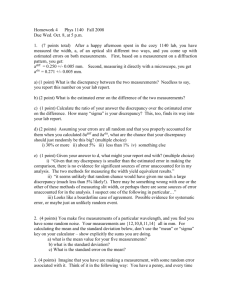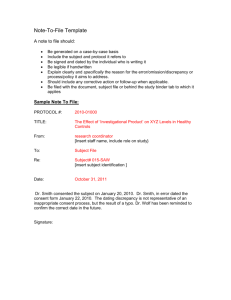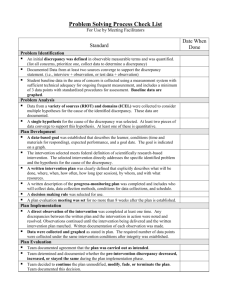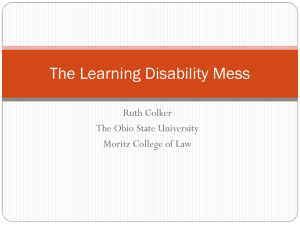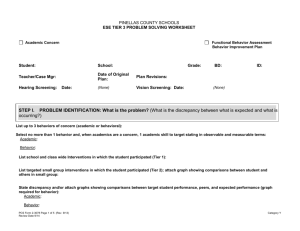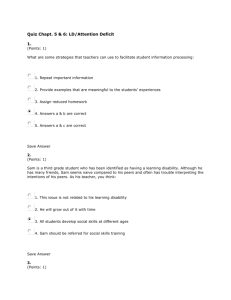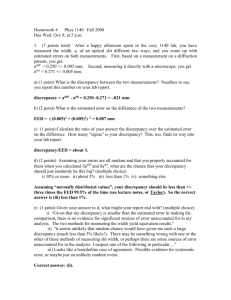- SUNY Oswego
advertisement
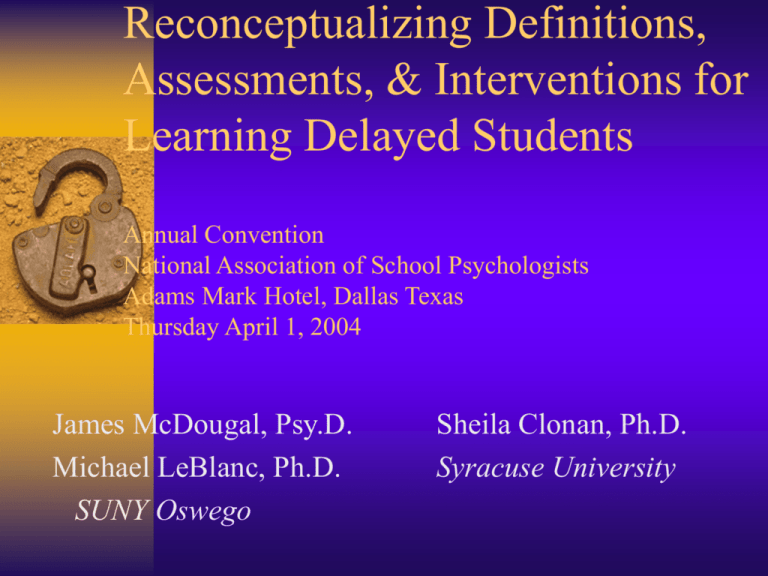
Reconceptualizing Definitions, Assessments, & Interventions for Learning Delayed Students Annual Convention National Association of School Psychologists Adams Mark Hotel, Dallas Texas Thursday April 1, 2004 James McDougal, Psy.D. Michael LeBlanc, Ph.D. SUNY Oswego Sheila Clonan, Ph.D. Syracuse University LD Assessment: Past and Future Discrepancy based procedures Problems with these models A new approach LD Assessment: Past & Future The Ghost of LD PAST – Current Definitional Concerns – What is LD? – What isn’t LD? – Discrepancy based models – Wait to fail LD Future – A New Era – Validated Models – Response to Intervention – Services First, Assessment Later – Monitoring techniques – What’s my role? NY Learning Disability Definition A student with a disorder in one or more of the basic psychological processes involved in understanding or in using language, spoken or written, which manifests itself in an imperfect ability to listen, think, speak, read, write, spell, or to do mathematical calculations. The term includes such conditions as perceptual handicaps, brain injury, neurological impairment, minimal brain dysfunction, dyslexia and developmental aphasia. The term does not include students who have learning problems which are primarily the result of visual, hearing or motor handicaps, of mental retardation, of emotional disturbance, or of environmental, cultural or economic disadvantage. A student who exhibits a discrepancy of 50 percent or more between expected achievement and actual achievement determined on an individual basis shall be deemed to have a learning disability IDEA's Definition of Learning Disability ". . . a disorder in one or more of the basic psychological processes involved in understanding or in using language, spoken or written, that may manifest itself in an imperfect ability to listen, think, speak, read, write, spell, or do mathematical calculations, including conditions such as perceptual disabilities, brain injury, minimal brain dysfunction, dyslexia, and developmental aphasia." However, learning disabilities do not include, "…learning problems that are primarily the result of visual, hearing, or motor disabilities, of mental retardation, of emotional disturbance, or of environmental, cultural, or economic disadvantage." Problems with these Definitions? Heterogeneity hypothesis: – A catch-all definition – what is LD & how do we intervene? Exclusionary hypothesis: – What LD is not vs. what it is – Difficult to justify – Routinely overlooked in practice Discrepancy Hypothesis: – Too many to list! Beginning with……. Example of State Requirements for LD Diagnosis Achievement Intelligence Discrepancy Severe Discrepancy Determination by Formula Kate obtains an IQ score of 90 and an achievement score of 74. Is this 16-point difference large enough to be considered a ‘significant difference’ between ability and achievement? Data: Ability Score ………………………………………………... 90 Reliability of Ability Score ……………………………. … 0.91 Achievement Score ……………………………………….. 74 Achievement Reliability ………………………………….. 0.91 Correlation Between Ability and Achievement Scores .. 0.47 Methods for Determining Severe Discrepancy Deviation from Grade Level Standard Deviation from the Mean Standard Score Comparison Regression Formula Deviation from Grade Level difference between grade level functioning and placement “Is a student’s measure of grade level functioning significantly different than his or her grade placement?” For example: – Kate is in grade 6 and is achieving at a 3rd grade level – the 50% discrepancy would be considered a severe discrepancy Deviation from Grade Level (continued) Problems: – grade equivalent scores are not based on equal units – learning is not linear – example: a third grader two years behind is not comparable to an 11th grader two years behind – least psychometrically sound method Standard Deviation from the Mean Difference between obtained achievement and normed averages Compares an individual to a group “Is a student’s score on an achievement test discrepant from the test mean by a standard value” To calculate: – change achievement score to z-score – compare the z-score to some predefined discrepancy (e.g., 1.5sd or 1.75 sd) Standard Deviation from the Mean (continued) Example of Kate – if a severe discrepancy is defined as 1.5 sd – Kate’s achievement score of 74 would transform to a z-score of (74-100)/15=-1.73 – Kate’s discrepancy would be considered a severe discrepancy Problems: – conceptually different from measures of intra-personal discrepancies & would qualify all low performing individuals – would not identify many students who would be expected to perform better than the average – does not consider measurement error Standard Score Comparison Difference between standard scores from ability and achievement tests Compares an individual to himself or herself To calculate: – obtain measures of achievement and ability – change scores to z-scores – subtract achievement z-score from ability z-score and divide by standard error of the difference – compare to predefined severe discrepancy score Standard Score Comparison (continued) Example of Kate – if a severe discrepancy is defined as 1.5 sd – Kate’s achievement score of 74 would transform to a z-score of (74-100)/15=-1.73 – Kate’s ability score of 90 would transform to a z-score of (90-100)/15=-0.66 – use formula (Zach-Zability)/((1-rxx) + (1-ryy))1/2 = (-1.73+.66)/.42 = -2.5 – compare -2.5 to 1.5 (note the severe discrepancy cutoff point is expressed as a positive value but think of it as a discrepancy between achievement and ability that would be a negative value when used to define ld) – because Kate’s discrepancy is larger than the predefined severe discrepancy – Kate’s discrepancy would be considered a severe discrepancy Standard Score Comparison (continued) Problems: – assumes that measures of ability perfectly correlate with measures of achievement – e.g., assumes that Kate’s measured IQ of 90 would mean that we expect her achievement score to be 90 – does not consider measurement error Regression Formula Difference between standard scores from ability and achievement tests using regression formulas – use regression to predict an individual’s achievement score from his or her ability score – includes corrections for measurement error and regression to the mean Regression Formula (continued) Example regression formula: y’ = rxy(Sy/Sx)(IQ - `x) + `y where: y’ = predicted achievement score rxy = correlation between IQ and achievement test Sy = standard deviation of achievement test Sx = standard deviation of IQ test `x = mean of IQ test `y = mean of achievement test Effects of Test Reliability or Error of Measurement 0.03 0 40 55 70 85 74 100 98 115 130 145 160 130 145 160 Score Tests with high reliability 0.03 0 40 55 70 85 74 100 98 115 Score Tests with low reliability Regression Formula (continued) After predicting achievement based on IQ – discrepancy is formed by calculating difference between actual and predicted achievement – the calculated discrepancy is tested for significance – is the discrepancy so large that we would consider it not likely due to chance? Determination is made Regression Formula (continued) Calculation discrepancy using a severe discrepancy calculator: Kate’s Ability Score Achievement Score 90 74 Reliability of Ability Score .91 Achievement Reliability .91 Correlation Between Ability and Achievement Scores .47 Regression Formula (continued) Predicted Achievement Score 95 – note: based on IQ score of 90, Kate’s predicted achievement score is “pulled towards the mean” Difference between Predicted and Actual Achievement 21 Magnitude of Difference required at .05 level 22 Kate’s discrepancy would not be considered a severe discrepancy Regression Formula (continued) Problems: – complex calculations – excludes many students in lower ability range who would be included using simple discrepancy method Benefit: – most psychometrically sound method Summary Determination of LD Diagnosis is based in part on: – State determinations of severe discrepancy – method of calculating severe discrepancy Different methods of calculating a discrepancy will result in different students being classified Validity Learning disability is result of unexpected low achievement. Also implies that children with unexpected low achievement (LD) are distinct from expected low achievement (i.e., low achievement and low intelligence). Validity Validity of construct relies on its uniqueness and utility Validity of a discrepancy based model assumes that ability-achievement discrepant children are qualitatively distinct from regular “low achievers. Also assumes that identifying LD will lead to useful interventions specific to that group. Assessing Validity of LD Fletcher et al. (2001) describe means of validating LD diagnosis – Prognosis – Response to intervention – Distinct cognitive profiles Cognitive Domains Meta-Analysis Hoskyn & Swanson (2000) Stuebing et al. (2002) Stuebing et al. Substantial overlap between IQ-discrepant & IQ-consistent poor readers Differences between groups on several cognitive domains were negligible or small Research indicates little need for using IQ tests in assessing LDs Prognosis Do LD students and ordinary low-achievers differ in development of reading ability? O’Mally et al. (2002) found little evidence of differences between groups. Several longitudinal studies found little or no differences in reading development between groups. Response to Intervention Research generally finds that discrepancy based LD vs. low-achievers do not respond differently to interventions. Vellutino, Scanlon, Lyon (2000) reported that IQ-achievement discrepancy did not predict differences between groups on responses to intervention or which group would be more easily remediated. Assessing Validity of LD: Summary Research indicates little or no differences between discrepancy based LD students and ordinary low achievers based on: – Cognitive Profiles – Prognosis – Response to intervention Validity Current definitions and diagnosis of LD students lacks uniqueness (distinct group of learners) and utility (clear differences in treatment and prognosis). A New Era: Revitalizing Special Education for Children and their Families President’s Commission on Excellence in Special Education July 1, 2002 Introduction to a New Era Students with disabilities drop out of high school at twice the rate of their peers Most public school educators do not feel well prepared to work with children with disabilities Introduction to a New Era Almost half of the children in special education are identified as having a specific learning disability- a 300% increase since 1976 80% of of those with SLD (40% of Sp Ed students) are there because they haven’t learned how to read 7 Sections- Assessment & Id changed most Federal Reg’s & Post secondary results, Monitoring, paperwork reduction, increased flexibility *Assessment & Identification Sp Ed finance Accountability, flexibility, parental empowerment effective transition services Teacher/administrator preparation, training, retention Sp Ed research and dissemination Assessment & Identification 1. Identify and Intervene Early “Services first, assessment later,” • Commissioner Steve Bartlett Assessment & Identification 2. Simplify the Identification Process. – And clarify the criteria used to determine the existence of a disability, particularly high incidence disabilities. I would like to encourage the commission to drive a stake through the heart of this over reliance on the discrepancy model for determining the kinds of children that need services. It doesn’t make any sense to me. I’ve wondered for 25 years why it is that we continue to use it and over rely on it as a way of determining what children are eligible for services in special education. • Commissioner Wade Horn Assessment & Identification Incorporate Response to Intervention. – Implement models during the identification and assessment process that are based on response to intervention and progress monitoring. Use data from these practices to assess progress in children who receive special education services The real tragedy is that conceptualizations of LD have not changed over 30 years despite the completion of significant research in the past 15 years. What we know form research now needs to be implemented. • Lyon, Fletcher, et al. Assessment & Identification Incorporate Universal Design in Accountability Tools. – Ensure all tools used to assess students for accountability and the assessment of progress are designed to include any accommodations and modifications for students with disabilities Assessment & IdentificationSummary …We are still in need of data indicating that the cognitive processing of dyslexic and garden variety poor readers reading at the same level is reliably different, data indicating that these 2 groups have a differential educational prognosis, and data indicating that they respond differently to certain educational treatments. These data of course should have been presented in the first place. Stanovich, 1991 New Assessment Models: NASP Recommendations Identification and Eligibility Determination for Students with Specific Learning Disabilities April 25, 2003 NASP Recommendations Maintain current LD definition but change eligibility criteria Eliminate ability-achievement discrepancy Introduce multi-tier model with dual criteria- significantly low underachievement, insufficient response to intervention Significantly Low Achievement States or School Districts may set criteria for “significantly low achievement” As in current law exclusionary criteria would still apply- not primarily the result of visual, hearing….. Insufficient Response to Intervention Despite at least 2 empirically based interventions over a period of at least 6 weeks Interventions administered in general education Lack of response not due to low effort, cultural differences, LEP, or nonattendance Continuum of Effective Support Tertiary Prevention Specialized Individual Interventions Students with Chronic/Intense Problems (1 - 7%) (Individual Student System) Secondary Prevention Students At-Risk for Problems Specialized GroupInterventions (At-Risk System) (5-15%) Students without Serious Problem (80 -90%) Primary Prevention Universal Interventions (School-Wide System Classroom System) Characteristics of the Multi-Tier Model Tier 1. High quality instructional and behavioral supports for all students in general education Tier 1. Components include.. Research based instruction & behavior supports Ongoing CBA of basic skills, instructional level matched to students skills Remedial instruction and group interventions within general education Characteristics of the Multi-Tier Model Tier 2. Targeted intensive prevention or remediation services for struggling students Tier 2. Components include.. Research based/intense services targeted to the student’s individual needs Time limited services Linked to a problem solving process including general & Sp Ed teachers and support services personnel Initiated though formal referral, parental notification and consent Tier 2. Problem solving includes. Precise charting of progress- general education interventions Formal documentation of progress toward targeted goals A verified level of intervention fidelity Comparison to local norms- if available Characteristics of the Multi-Tier Model Tier 3. Comprehensive evaluation by a multi-disciplinary team to determine eligibility for special education and related services Tier 3. Components include.. Low achievement and insufficient response criteria met Referral to a Multidisciplinary Team MDT conducts a comprehensive evaluation Assessment through intervention: A New IDEA? Monitoring and Evaluation Implications for Intervention Monitoring Techniques: Academic Curriculum Based Measurement (CBM) – Reading- fluency, accuracy, some comprehension – DIBELS- to assess pre/early-literacy skills – Math- fluency, accuracy, basic calculations – Written expression- fluency, accuracy Monitoring Techniques: Academic Other Techniques: • Permanent Product Monitoring- homework, class assignments, etc • Test/ Quiz Grades • Others.. CBM- Monitoring Interventions CBM- Testing Interventions CBM- Testing Interventions Evaluating Interventions Evaluating Interventions BILLY'S DIBELS SCORES 18 16 14 SCORES 12 ISF 10 PSF LNF 8 NWF 6 4 2 0 1 2 3 4 DAYS 5 6 Implications for Intervention Assessment techniques should lend themselves to intervention Assessments that measure important subskills, are repeatable and directly related to instruction Case Example: Using Dynamic Indicators of Basic Early Literacy Skills (DIBELS): Background Subtest: Letter Naming Fluency (1st Grade) – Administered K & early 1st grade – Student presented with upper & lower case letters in random order and asked to name as many as they can in one minute – Students are told that if they don’t know a letter it will be told to them – < 25 LNF = at risk; 25-37= Some Risk; > 37 Low Risk Case Example: Using Dynamic Indicators of Basic Early Literacy Skills (DIBELS): Background Subtest: Phoneme Segmentation Fluency (1st Grade) – Assesses students’ ability to segment 3- and 4phoneme words into individual phonemes – Words are presented orally – Student is asked to say each sound they hear – PSF < 10 Deficit; 10-35= Emerging; >35= Established Case Example: Using Dynamic Indicators of Basic Early Literacy Skills (DIBELS): Background Subtest: Nonsense Word Fluency (1st Grade) – Assesses student knowledge of alphabetic principle – Ability to blend letters into “words” – Student given page with nonsense words and asked to read as many as can in 1 minute – NWF < 13= At Risk; 13-24=Some Risk; >24=Low Risk DIBELS Case Example 1st grader, Fall DIBELS: – Letter Naming Fluency: 30 – Phoneme Segmentation Fluency: 9 – Nonsense Word Fluency: 16 What to do? DIBELS Case Example Benchmark 1 Fall 1st gr. Letter Naming Fluency – <25 At Risk – 25-37 Some Risk – >37 Low Risk Phoneme Segmentation Fl – < 10 Deficit – 10-35 Emerging – > 35 Established Nonsense Word Fluency – <13 At Risk – 13-24 Some Risk – >24 Low Risk “Johnny” LNF= 30 PSF= 9 NWF= 16 DIBELS Case Example What to do? What are the areas of concern? How might these be problematic? How can we address them? How can we monitor his progress? Phonological Awareness and the Instructional Hierarchy Instructional Instructional Stage Principles Examples Acquisition (accuracy) Modeling Prompting Say it-Move it Letter Cards Fluency Drill & Practice Reinforcement of correct responses Generalization Practice and more practice! “Mad Minute”/speeded activities; Word sorts, Concentration, etc. Reading controlled text Reading; Variety of PA activities 2nd Grade Case Example Oral Reading Fluency: 24 (At Risk) Early reading skills “intact” Needs substantial intervention in reading fluency Suggestions? Oral Reading Fluency Building Activities Practice Reinforcement Generalization Practice Reading Practice Repeated readings Characteristics of Good Interventions Explicit Systematic Structured Focused and Appropriate Resources for Assessment and Instruction Free Reading Resources Free Assessment & Intervention Resources Other Tools Free Reading Resources http://www.nationalreadingpanel.org/Publications/summary.html Report of the National Reading Panel http://www.ed.gov/index.html US Department of Education See publications- search for reading http://www.ericec.org/osep-sp.html The ERIC/OSEP Special Project- Offers Research Connections, Newsbriefs, Topical Briefs, and Awareness campaigns such as Learning to Read, Reading to Learn. Free Reading Resources http://www.reading.org/ International Reading Association http://www.ldanatl.org/ Learning Disabilities Association http://www.aft.org/edissues/downloads/remedial.pdf American Federation of Teachers- Building on what works. Five promising reading remediation programs www.ncela.gwu.edu/iasconferences/institutes/diverse/sevenele ments.ppt Seven elements of a school wide beginning reading program Free Reading Resources-Reading First http://www.fcrr.org/ Florida Center for Reading Research. Provides scientifically supported reading curriculum guides and lists validated intervention programs http://reading.uoregon.edu/curricula/or_rfc_review_2.php Oregon Reading First Center- Provides empirical reviews of validated assessment and instructional programs (many reports that are able to be downloaded http://www.texasreading.org/utcrla/default.asp The University of Texas Center for Reading and Language Arts (UTCRLA) www.nifl.gov The National Institute for Literacy-See the “Putting reading first” report Free Assessment & Intervention Resources http://dibels.uoregon.edu/ Good & Kaminski (2002). Dynamic indicators of basic early literacy skills. Complete assessment and manual with probes for letter naming fluency, initial sound fluency, phoneme segmentation fluency, nonsense word fluency, oral reading fluency and retell fluency, word use fluency Free Assessment & Intervention Resources http://bitwww1.psyc.lsu.edu LSU Reading Center (Joe Witt). Materials for reading placement, reading intervention, and CBM assessments, instructions, and probes. Free Assessment & Intervention Resources http://www.interventioncentral.org/ Jim Wright with the Syracuse City School District. Excellent resource compilation of assessment, academic and behavioral interventions Favorite Downloads include Classroom Behavior Report Card Manual, Curriculum-Based Measurement Manual & CBM Workshop, Peer Tutor Training, Reading Interventions Manual, School-Based Intervention Team (SBIT) materials. Also has a CBM Graphing program (Chartdog) and excel. Free Assessment & Intervention Resources http://alpha.fdu.edu/psychology/ Ron Dumont and John Willis. This website offers an array of resources for assessment and diagnosis including test reviews, classification guidelines, etc. And of course……….. http://www.schoolpsychology.net/ School Psychology Resources online - Sandra Steingart, Ph.D. http://www.nasponline.org/index2.html NASP Contact Information James McDougal, Psy.D. mcdougal@oswego.edu Michael LeBlanc, Ph.D. leblanc@oswego.edu Sheila Clonan, Ph.D. smclonan@syr.edu

